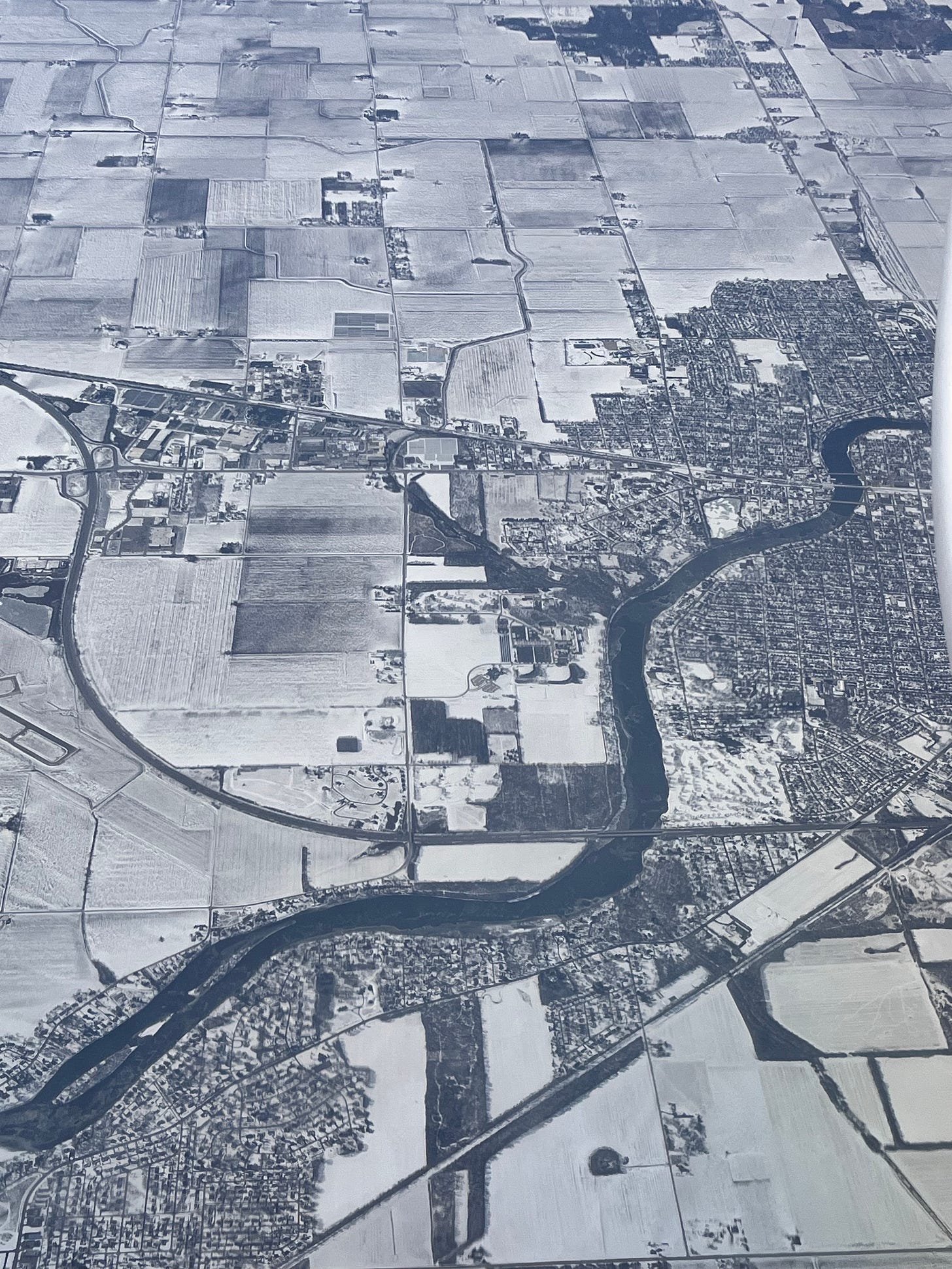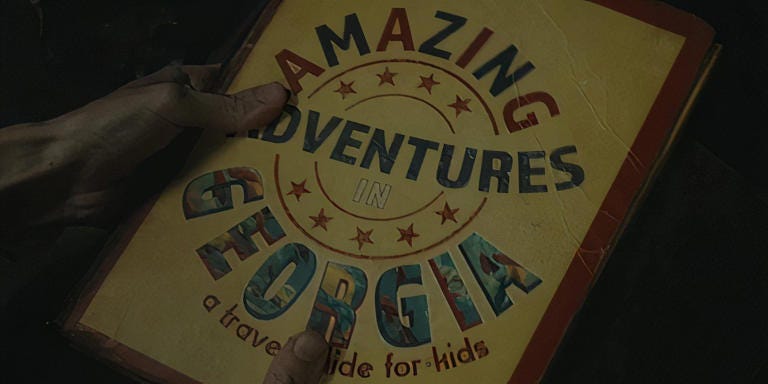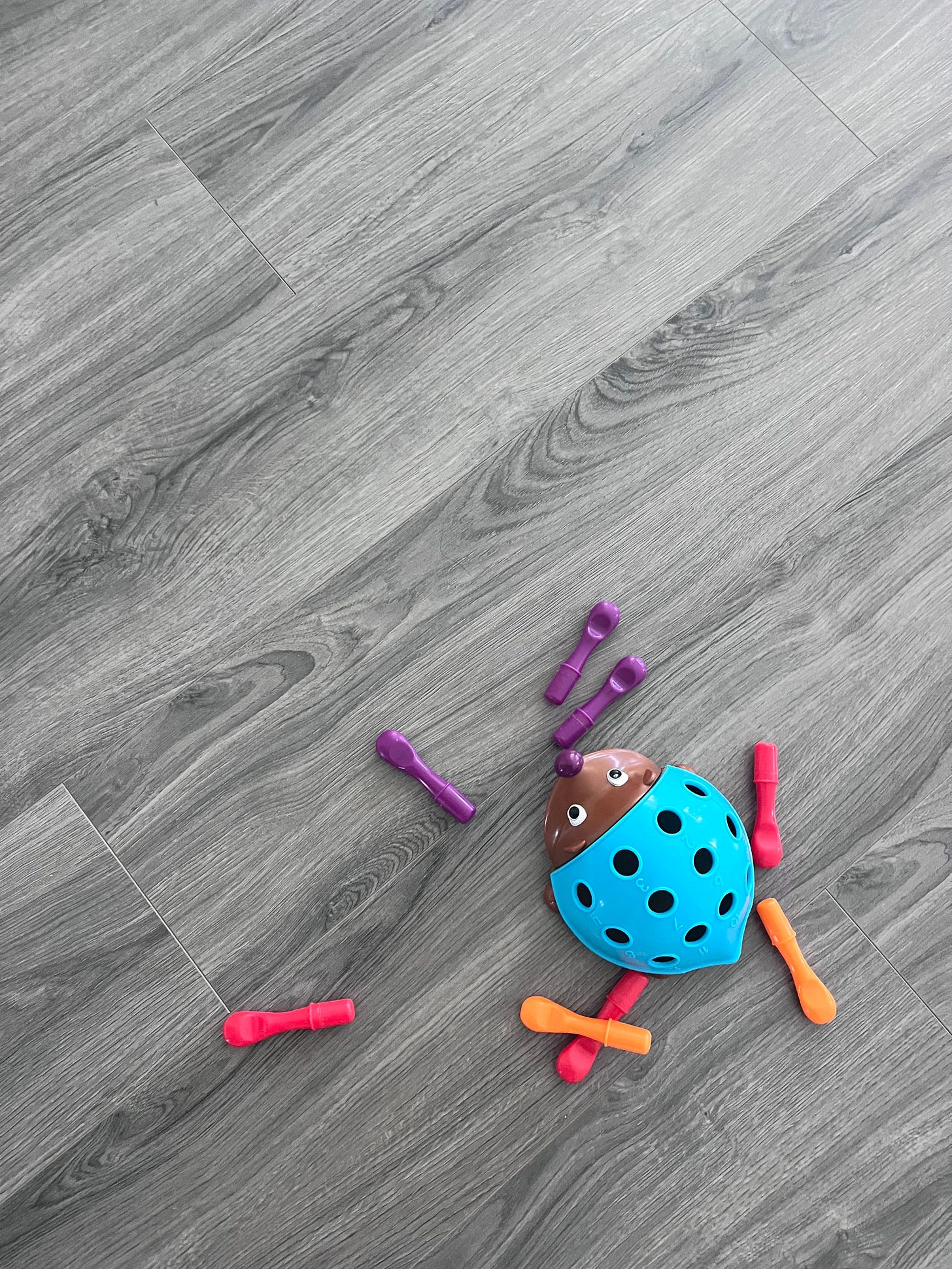My baby just ate the heads of four birds
On magical thinking, Muscogee beliefs, Mickey Mouse, the man-made, and the man-forgotten.
My baby just ate the heads of four birds, I announce to no one.
In my dream, Aoife was balancing her bodiless head on a branch where four little birds sat—white, black, and bluish with puffed-out chests, and then Aoife looked up—her steely eyes placid and serene, then ate their heads. Whole.
One after another after another after another.
There was no blood or gruesome remains. No carrion or carnage. Just the simple act of eating, then the quiet hollow. Necks razed by incisors. Feathers floating down.
So shocking an action, I carried it past waking and into wakefulness—clenching my green coverlet, sharing this happening blindly, urgently with the four walls of my room.
It was not the eating it seemed that was important.
It was also not that they were birds. Or even little birds, too.
It was the fact that they were four.
Like a certain rock in an uncertain stream, the number four created order among the unsettling imagery of my dreamscape, but the number also felt oddly emblematic, portending—as did my general unfeeling.
The fourness had something to do with Aoife, with me, with this place—a small city bordering Alabama, hugging the Chattahoochee.
That morning as I cut up four pounds of beef and poured beef stock, au jus gravy, a packet of ranch, and a glass jar of pepperoncinis into a crockpot, I told M about it—explained the birds must have been modeled in my mind after Carolina chickadees. The same little birds that land on my “office” windowsill—black capped, black bibbed, with round white cheeks. Then, I joked to M that I never thought I’d be in the heart of the Georgia talking about Carolina chickadees making a Mississippi Pot Roast—forgetting that actually while Columbus may seem a random point, the South should be in me, of me.
Columbus is not the exact place but near the place my great-great-great grandparents' called home, and their parents’ home and their parents’ home.
The Muscogee were referred to as “Creeks” by white settlers because they lived along the South’s waterways including the Chattahoochee River, the river just meters away from our rental, with its dark paint, weathered and sloping porch, peeling bricks.
It should now come as no surprise that in Muscogee culture, the number four is important. Four, like in many Native cultures, is seen as the number of balance. Everything coming from the Creator in fours: the four cardinal directions, the four elements, the four seasons, even four stages of life. Nature moving always through these little (or big) quartets—at the end of a thing, the beginning of another; after a return, only then another death.
*
Later in the week, we visited T’s family home located in the midwest, and on the way back, I took photos from the sky. Frame after frame of a snow-dipped Chicago than the white-on-white cornfields of Illinois. Terrified of flying, I was sedate, because I was on sedatives. Drunk, because I was slightly drunk. And, being these two things, I felt perceptive—or maybe receptive. I took tens if not hundreds of photos of the whiteness. Six-mile square townships subdivided into one-mile square sections: the white only cut by the incision lines of Manifest Destiny.
Still floating lightly in my body when we landed in back in Georgia several hours later and hundreds of miles southeast, I fixated on something new across the state’s looser script. I noticed the warm sun reflecting off our planes’ wingtips and from the wingtips off the state’s waterways—the lakes and springs, streams, rivers, creeks. Then, I filmed the bouncing, cascading light.
The glow traced felt something altogether magical—like the shimmering effect of the moon against the lagoon in Disney’s The Little Mermaid, or Midas touching just about everything. A glint at every stream’s bend, a glimmer at every elbow of a lake, or river. The light beginning, crescendoing, declining, beginning again like some ribbon of continuance.
Two days later, as if by a darker magic, someone in a workshop noted how when you travel—especially by plane or train, your eyes often catch the light and its jumping—off waterways, yes, but also pieces of man-made then man-forgotten objects. Castoffs of industry, or what she called “shrapnel.” Odd knick knacks lodged in the dirt or emerging like unexploded ordnances from lone flowerbeds. Junk metal piled in the backlot of a superstore. Flyaway plastic wrappers on the pavement at a 7-Eleven.
America: not a ribbon of continuance, but a ticker tape of merchandised death.
*
Back at home and a day after my workshop, I stopped in the middle of rewriting a poem about the dream of Aoife eating the heads of four birds that began “I dream my baby ate the heads of four birds,” to go watch Aoife, no longer eating the head of birds, in her reading group.
When I arrived, the two librarians were at the fore of the room stepping awkwardly from side to side while hoisting furry monkey puppets in the air to the lyrics of “Five Little Monkeys.” While the other babies sat quietly in their parents laps, Aoife stood directly in front of the two librarians. As they sang, she shook her head up and down as if she was a preacher performing an exorcism. She wiggled—much to the delight of all the parents—her little pointer fingers no, no, no, no, no while shimmying down to the ground, then squelched her hands in goodbye motions when the librarians put away each fallen monkey. After the song ended and all goodbyes were said, playtime commenced—Aoife running with the other children to forage little pieces of plastic from the metal cart the two librarians wheeled out. Then, when she tired of toys she alone attained, she scavenged what was left on the spines of other abandoned toys strewn on the floor—toys tested then tired of then somehow scraped, deboned, filleted for others to harvest.
Like a bowerbird making a nest, she collected wooden puzzle pieces, plastic hamburger and hotdog buns, yellow squares filled with multi-colored beads that shook into rainbow sprinkles, then came to place them before me in a randomly patterned circle.
She: being happy, busy in a collared dress with yellow and brown flowers, elasticized sleeves, and little white stockings.
Me: feeling royal and also like the backlot of a grocery store, the ground of a 7-Eleven.
Me: somewhat irked that her flower-dotted dress was sharply contrasted by her beige sneakers, their awful sequined stars.
For a long time postpartum, the need to control, maintain, manage, count was all-consuming. As were the intrusive thoughts. As was the magical thinking.
Early on, I wrote:
Also, I want more Itty Bitty Knot headbands for my baby.
I know this, too, is my illness…
The collecting started when I was 9.
The subconscious thought early postpartum, similar to a thought I had as a child was: without the collection, perfection, a lack of wholeness. The desperate need to hold everything in its original form.
The resulting compulsion was to buy one in every shape, pattern, color, form. The same baby bows but in pink, burnt orange, sea foam green. The same Mom jeans but one with added volume, one with a crossover front, one with an adjustable tie, one with extra panels.
And, yet, despite this, or maybe subconsciously in spite of this, I’d been—outside of my body, home—drawn to breakage. The knick knacks lodged in the dirt or emerging like unexploded ordnances from lone flowerbeds. In the little time I got by myself post-baby, I walked around and photographed refuse in the wild. In Key West: refrigerators left gleaming at the side of the road, empty wine coolers resting among petunias in trash cans, ratty chairs set on the side of the street like ladies in mourning. In Columbus: forgotten fire hydrants, shreds of bags, twisted necks of cigarettes, a Mickey Mouse figurine with but only one large, rounded ear. The space where the other ear should be: a disquieting emptiness. Existence, halved.
*
This week, like the rest of the country, I wake every morning to real carnage. The government being gutted for parts. Civil servants being fired from jobs they have dedicated themselves wholly to, in places and communities they selflessly serve. Immigrants being forcibly deported for simply not being of a place in this place.
If I’m being honest, I haven’t felt like myself in days. I struggle to watch my child when I’m supposed to watch my child. I struggle to work when I’m supposed to work. I can’t get enough sleep, because there is simply not enough time in the day to sleep. And, when I can’t sleep, I just want to escape the paralysis of existing. Murakami’s The City and Its Uncertain Walls on my nightstand table. The dystopian drama Silo, with all its frightening parallels and puppets and puppet masters, lulling me to sleep.
Set in a massive underground bunker known as “the Silo,” Silo documents a time when the last of humanity lives under ground under strict rules and the belief the outside world is toxic, uninhabitable.
In an effort to forbid the questioning the past, the Judicial branch of the Silo has banned something called “relics,” effectively things our future selves would consider trash—pre-Silo books and Pez dispensers, outdated watches and CD-ROMs. Each relic a clue to a former, different existence, making their existence a potential fracture in the collective forgetting.
In Season 1, there is one relic in particular that seems rather dangerous due to the feelings of longing it induces, and due to its danger, it is incinerated in Episode 9. Those who came in contact with the book Amazing Adventures in Georgia: A Travel Guide for Kids are drawn to the glossy pages that showcase Georgia in its best light—the blue of its ocean, the sand off its beaches, the lush green of its trees, and when the main character Jules first comes to it, she caresses its first page lovingly. A page detailing the Chattahoochee River National Recreation Area, an area around the river along which my ancestors lived. The same river just four blocks from where I sit now in my rental—with its dark paint, weathered and sloping porch, peeling bricks.
*
As I write this today, Aoife is collecting plastic purple and orange quills for her plastic blue-backed porcupine in the hall, which (while I am trying hard not to be) I am at times very possessive over—the quills needing to find their way into porcupine’s back at the end of each day.
In a tiered, floral dress set over her berried-stained pajamas with half-broken green and pink bangles running the length of her arm, Aoife is foraging the quills where she alone once planted them only an hour before—in my biking cleats, beneath our wooden coat rack, in the understory her second-hand stroller.
While I listen to her, I look out the window. From this perch, I know I will see the delivery person make their rounds in their brightly colored shirt replete with an enterprise smile and catch students from Columbus State carrying their instrument cases to or from class. I will see the grass glow green in the midday then dull to its cold brown, the cats bat at low-flying insects then bathe their tender coats in the soupy light, maybe a Caroline chickadee, or two. As I often do, I will stare at the planter against the brick stairs that lead to our rental absently. In it sits a single pinwheel shaped like a flower, all of its yellow tear-drop petals—but two—gone.
But, today, unlike other days, I will notice the window itself, how it is laced with peeling latex caulking and how it is divided into discrete quadrants, the quadrants allowing me still a season or a tiny bird or a leafless plastic flower.
I realize now I think I know to what the dream was telling me.
About fourness. And, maybe wanting. And, maybe loss. And, also forgetting.
There will always be a Carolina chickadee and then that chickadee without a head. A dress and then that dress without its signature Mary Janes. A mouse and then that mouse without an ear. A porcupine and then the same porcupine without its quills.
Or, put differently: there was a river I could have once known, but that river has since gone. The bends, twists, turns—forever beautiful and forever unknowable.
Like the blue of the ocean in the Silo, I can touch the gloss, rub the paper of its belly, but I can’t truly sink into it, feel it, be held in its every turn. A shape remains, but the thing itself is not even an echo to the touch. Non-memory being the point.
Non-memory having been the point all along.






